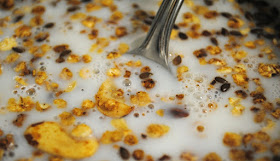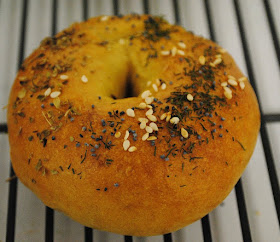As anyone who's ever lived within earshot of me knows, I am an avid listener and frequent singer of Greek music. You give me a track that's heavy on bouzouki and features a mellifluous, Greek voice drenched in emotion, and I guarantee I'll be singing along in minutes, even if I'm not quite sure what's being said. Maybe it's the way the vowels, the r's and the d's sound so much like those in Spanish, or maybe it's the way music absolutely has a way of transcending national borders. Whatever the reason, the way I see it, if you want to know about passion (in terms of both pleasure and pain) just listen to the likes of Giorgos Dalaras and Glykeria for a lasting dose. If they don't set your soul ablaze, your heart may just be made of stone.
I'm just saying... you might want to get yourself checked out* ;)
Enter my love of Greek cuisine. I'll save my verbal musings for another day, but for now, let it suffice to say that I was literally jumping for joy on my last birthday when 'Chefski surprised me with the most mouth-watering feast from a Greek deli whose food I'd been dying to taste.
That meal inspired this culinary adventure. From what I've researched, Γιουβέτσι, a.k.a. Giouvetsi (pronounced yoo-VET-see), is a classic Greek casserole that involves tomato sauce, orzo, and whatever protein you like. This one stars shrimp, though I definitely want to try chicken and lamb versions down the line :)
Γαρίδες Γιουβέτσι ~ Shrimp Casserole
Adapted from a recipe on this cool Greek-cuisine website Kalofagas
Serves: 4
Ingredients
2 cups of shrimp raw shrimp with shells (preferably deveined, but if not you can do that pretty easily)
4 cups water
1/8-1/4 cup Extra Virgin Olive Oil (I used closer to 1/8 and that was enough)
1 small red onion, thinly sliced (original recipe calls for 6 scallions, which I'll consider using next time)
1/2 green bell pepper, diced
(and if you have them: 2 Tablespoons chopped fresh parsley, 1/4 cup grated carrot, 1/4 red bell pepper)
5 cloves garlic, finely chopped
(and if you have them: 2 Tablespoons chopped fresh parsley, 1/4 cup grated carrot, 1/4 red bell pepper)
5 cloves garlic, finely chopped
1 Tablespoon tomato paste
1 cup orzo
pinch of red pepper flakes
pinch of oregano
dash of dill
salt and pepper to taste
Directions
1. Peel the shells off your shrimp and collect in a bowl. Why? You're gonna make shrimp stock for your orzo! This is also the point at which I take the tails off the shrimp, because for me there's little worse than being bothered with shrimp-tails when I'm just trying to eat.
2. If your shrimp aren't deveined, make sure to do so now. Check out this video for tips on how. Rinse and drain your shell-free shrimp, place in a separate bowl and keep in the fridge til it's time to cook them.
3. Place the shells and a pinch of salt in a pot with 4 cups of water and bring to a boil. Let simmer for about 20 minutes. Your liquid will reduce by about 1/4.
4. In a large skillet (I used my favorite stainless steel casserole pan), heat your olive oil over medium heat and saute your diced pepper, garlic, and sliced onions for about 5 minutes, adding a pinch of salt to help the vegetables sweat.
5. Add the tomato paste to the vegetables and stir a bit to coat them well.
6. Add the dry orzo. Toss around to toast the pasta a bit and coat with the tomato paste.
7. Strain your shrimp stock and discard the shells. Add the stock to your orzo, bring to a boil, and continue to stir occasionally. Meanwhile, preheat the oven to 375 F.
8. Adjust seasoning by adding salt and pepper and the pinch of red pepper flakes.
9. Since I've used this casserole pan both on stove-top and in the oven before, I felt comfortable placing it directly in the oven for this step. However, you can also place the orzo in any oven-safe dish at this point. You should have about an inch of liquid above the orzo, and if not, just add some water and adjust the seasoning. Bake in the oven for 30 minutes, and while this is going on, take your shrimp out of the fridge and allow to come to room temperature.
10. After 30 minutes have elapsed, add the oregano and dill, stir, then place your shrimp atop the bed of orzo, and bake for an additional 5 minutes, until the shrimp are orange and have formed a C-shape (this is a tip courtesy of Kalofagas... apparently, if your shrimp have formed an O-shape, you've overcooked them). Enjoy the fruits of your labor (and these fruits de mer, fruits of the sea).



























